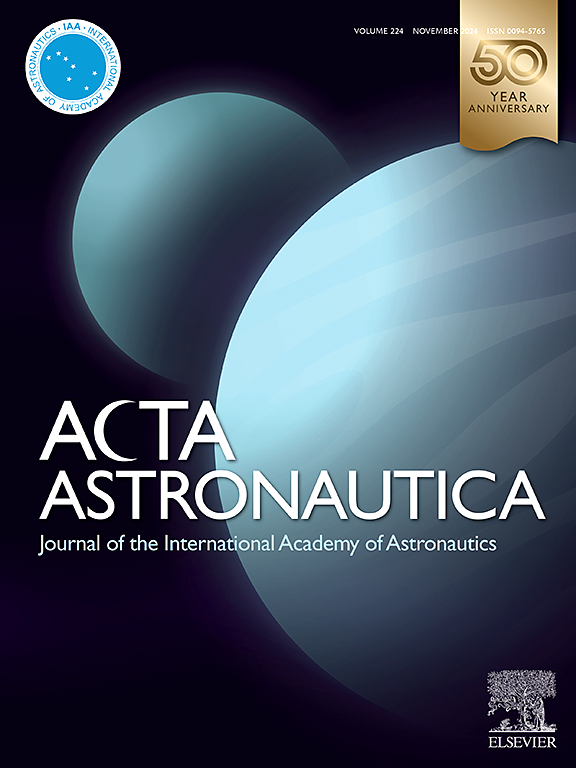太阳能卫星准太阳指向姿态的迭代控制方法
IF 3.1
2区 物理与天体物理
Q1 ENGINEERING, AEROSPACE
引用次数: 0
摘要
太阳能卫星超大型太阳阵列准太阳指向姿态解决了太阳指向姿态控制燃料消耗大、结构振动幅度大和重力梯度稳定姿态太阳辐射捕获效率低的问题。然而,由于QSP姿态的解析解尚未得到,导致客观姿态未知,QSP姿态的控制面临着很大的挑战。在此基础上,提出了一种不受客观姿态影响的基于二分法或割线法的QSP姿态迭代控制方法。首先,建立了太阳能电池阵的姿态动力学方程。然后,将姿态运动的连续过程划分为多个周期。利用迭代法对奇周期初始条件进行调整,得到精确的QSP姿态初始条件。在偶周期,采用五次多项式轨迹规划和前馈反馈控制器,得到偶周期规定的终端姿态条件,同时也是奇周期的初始条件。最后,考虑惯性参数、结构柔性和控制频率的影响,通过数值仿真验证了所提出的迭代控制方法。数值结果表明,当控制频率比结构的最低固有频率小一个阶时,可以获得QSP姿态。本文章由计算机程序翻译,如有差异,请以英文原文为准。
Iterative control method for quasi-Sun-pointing attitude of solar power satellites
Quasi-Sun-pointing (QSP) attitude for ultra-large solar array of solar power satellites solves problems of enormous control fuel consumption and large-amplitude structural vibrations for Sun-pointing attitude and the problem of low solar radiation capturing efficiency for gravity-gradient-stabilized attitude. However, the control of QSP attitude meets great challenges because analytical solution for the QSP attitude has not been obtained, and consequently the objective attitude is unknown. Thus, an iterative control method for QSP attitude is proposed based on dichotomy or secant methods, which is free of objective attitude. Firstly, the attitude dynamic equations of the solar array are established. Then, the continuous process of attitude motion is divided into multiple periods. The initial conditions of the odd periods are adjusted using iterative methods to find the accurate initial conditions of the QSP attitude. In even periods, quintic polynomial trajectory planning and feedforward-feedback controller are employed to obtain the prescribed terminal attitude conditions of even periods, which are also initial conditions of odd periods. Finally, the proposed iterative control method is validated through numerical simulations considering the influences of inertial parameters, structural flexibility, and control frequency. Numerical results reveal that QSP attitude can be obtained if the control frequency is one order smaller than the lowest natural frequency of the structure.
求助全文
通过发布文献求助,成功后即可免费获取论文全文。
去求助
来源期刊

Acta Astronautica
工程技术-工程:宇航
CiteScore
7.20
自引率
22.90%
发文量
599
审稿时长
53 days
期刊介绍:
Acta Astronautica is sponsored by the International Academy of Astronautics. Content is based on original contributions in all fields of basic, engineering, life and social space sciences and of space technology related to:
The peaceful scientific exploration of space,
Its exploitation for human welfare and progress,
Conception, design, development and operation of space-borne and Earth-based systems,
In addition to regular issues, the journal publishes selected proceedings of the annual International Astronautical Congress (IAC), transactions of the IAA and special issues on topics of current interest, such as microgravity, space station technology, geostationary orbits, and space economics. Other subject areas include satellite technology, space transportation and communications, space energy, power and propulsion, astrodynamics, extraterrestrial intelligence and Earth observations.
 求助内容:
求助内容: 应助结果提醒方式:
应助结果提醒方式:


